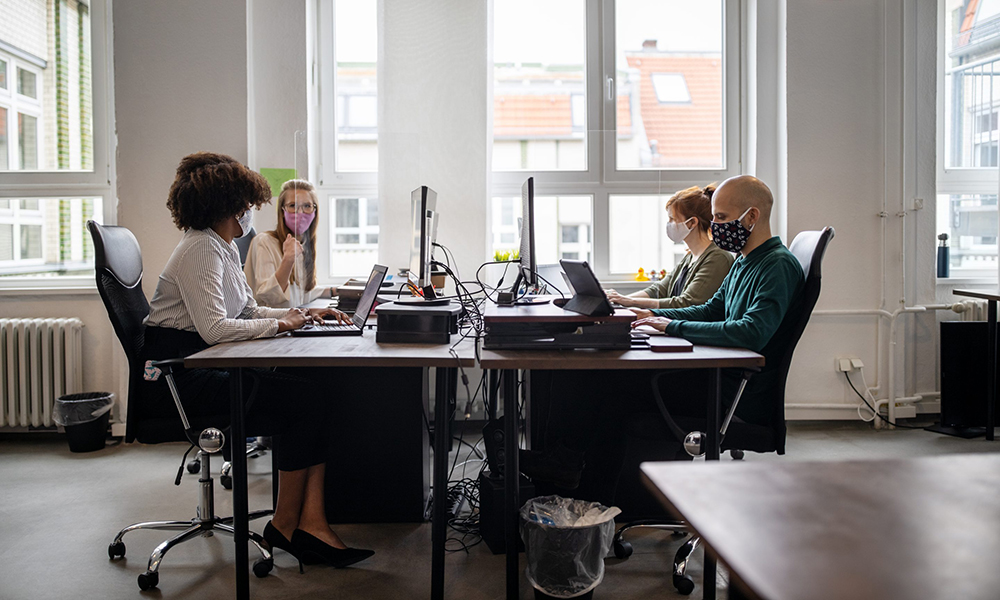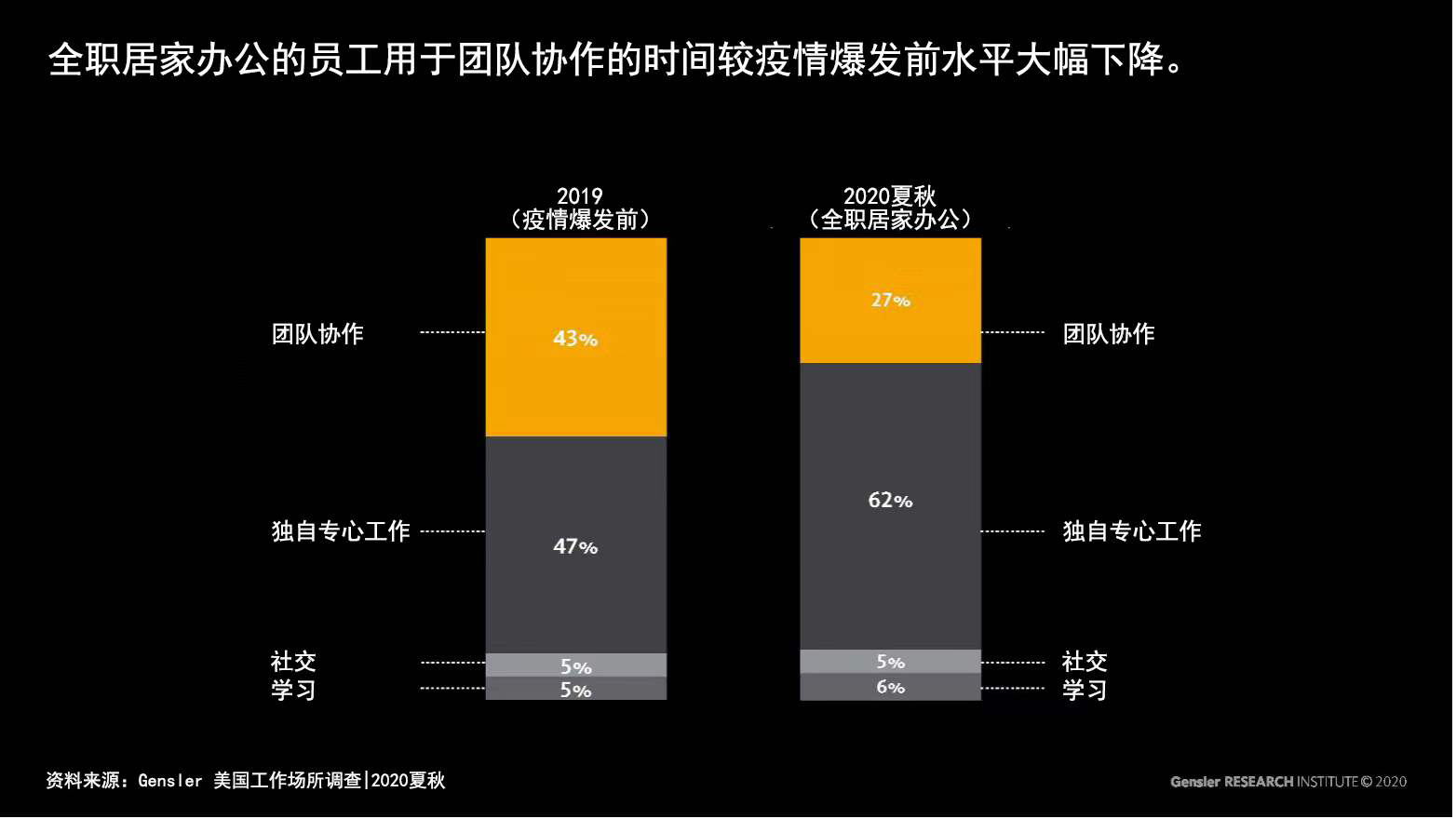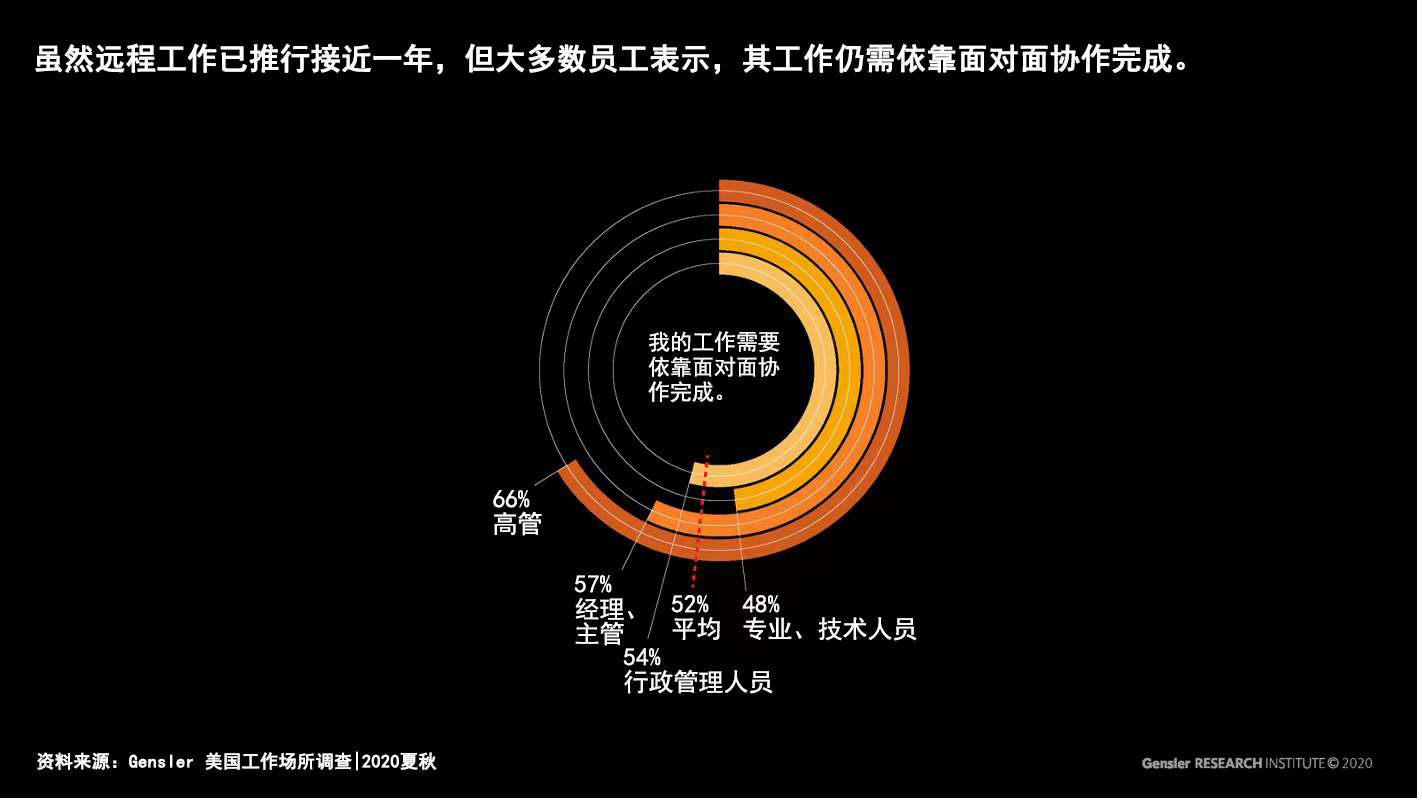
在新冠疫情期間,,許多人被迫離開了自己每天辦公的工作場所,轉(zhuǎn)為居家辦公,,我們也迅速適應(yīng)了這種不斷變化的環(huán)境,。相較過往,現(xiàn)在的工作場所已經(jīng)有了明顯的變化,,而這種突如其來的轉(zhuǎn)變也給了我們對線上辦公的有效性進(jìn)行大規(guī)模測試的機(jī)會,。
Gensler最近的一項(xiàng)研究發(fā)現(xiàn),由于新冠疫情期間陡然轉(zhuǎn)向居家辦公,,團(tuán)隊(duì)協(xié)作因此遭受了重大沖擊,。自2019年至2020年,團(tuán)隊(duì)協(xié)作水平大幅下降,,這一現(xiàn)象表明,,純粹的線上工作環(huán)境可能會(對團(tuán)隊(duì)協(xié)作)產(chǎn)生極大的負(fù)面影響。這項(xiàng)新發(fā)現(xiàn)無疑給那些正在制定返崗辦公方案的企業(yè)敲響了警鐘,。(Gensler是一家設(shè)計(jì)及建筑公司,,負(fù)責(zé)為客戶提供工作環(huán)境方面的建議,包括返崗辦公相關(guān)事宜,。)
Gensler對工作場所需求及行為的追蹤已經(jīng)持續(xù)超過15年,,并在2020年進(jìn)行了多項(xiàng)研究,為市場提供了許多疫情前及疫情期間的相關(guān)數(shù)據(jù),。在新冠疫情爆發(fā)前,,美國職員平均每周有43%的工作時(shí)間用于線上或線下協(xié)作,而在2020年居家辦公的職員群體中,,這一數(shù)字下降到了27%的水平,。
這意味著,相較新冠疫情爆發(fā)前,,全職居家工作的員工用于團(tuán)隊(duì)協(xié)作的時(shí)間下降了37%,。

通過上述發(fā)現(xiàn)可以看出,居家辦公已經(jīng)打破了企業(yè)的既有平衡,。通常情況下,,頂尖公司的優(yōu)秀員工花在獨(dú)自專心工作和團(tuán)隊(duì)協(xié)作上的時(shí)間大致相同——各占45%,,剩余10%的時(shí)間則用于學(xué)習(xí)和社交。正是由于員工在獨(dú)自專心工作和團(tuán)隊(duì)協(xié)作兩方面投入的時(shí)間大致相當(dāng),,企業(yè)才得以獲得當(dāng)今市場動態(tài)組織所需具備的速度和靈活性,。
而封城期間的數(shù)據(jù)則大不相同。新冠疫情期間,,居家辦公的員工將大約62%的時(shí)間花在了獨(dú)自專心工作之上,,而用于團(tuán)隊(duì)協(xié)作的時(shí)間則降低為27%,這種變化對公司的創(chuàng)造力和生產(chǎn)力都產(chǎn)生了負(fù)面影響,。
研究人員對協(xié)作重要性的衡量和記錄已經(jīng)持續(xù)了數(shù)十年,。正如2014年德勤(Deloitte)關(guān)于協(xié)作經(jīng)濟(jì)的一篇報(bào)告所總結(jié)的那樣,協(xié)作的商業(yè)價(jià)值能夠從六個(gè)關(guān)鍵領(lǐng)域來衡量和定義:速度,、工作質(zhì)量,、創(chuàng)新與新想法、員工敬業(yè)度,、增長和盈利能力,。團(tuán)隊(duì)協(xié)作可以幫助企業(yè)提升在上述所有領(lǐng)域的表現(xiàn)。

那么全新的工作模式應(yīng)該是什么樣的呢,?
許多“混合解決方案”建議對工作日進(jìn)行劃分,,部分工作日“居家辦公”,其余工作日“在辦公室辦公”,,但事情可能并非那么簡單,。對大多數(shù)員工而言,無論是獨(dú)自專心工作還是團(tuán)隊(duì)協(xié)作,,其工作內(nèi)容中均有正式與非正式,、計(jì)劃內(nèi)與計(jì)劃外的部分,而且不同類型工作的比重隨時(shí)可能發(fā)生變化,,每一天的工作內(nèi)容可能也都各不相同,。正常情況下,要想完成工作,,必須進(jìn)行有計(jì)劃的非正式接觸,,而“混合工作模式”對工作日的簡單劃分顯然無法滿足這方面的需求。我們建議在正式施行混合工作模式之前,,先對其進(jìn)行完善,、研究和測試,使之獲得良好的平衡,。
通過打造設(shè)計(jì)均衡的工作模式,、為團(tuán)隊(duì)協(xié)作和獨(dú)自專心工作提供支持,組織的整體能力和競爭優(yōu)勢都能獲得提升,。如果以這種方式重構(gòu)工作場所,,那么協(xié)作經(jīng)濟(jì)就將有望實(shí)現(xiàn)較新冠疫情前基準(zhǔn)水平更高的創(chuàng)新和增長,。(財(cái)富中文網(wǎng))
黛安娜·霍斯金斯是Gensler的聯(lián)席首席執(zhí)行官
譯者:梁宇
審校:夏林
在新冠疫情期間,許多人被迫離開了自己每天辦公的工作場所,,轉(zhuǎn)為居家辦公,,我們也迅速適應(yīng)了這種不斷變化的環(huán)境。相較過往,,現(xiàn)在的工作場所已經(jīng)有了明顯的變化,而這種突如其來的轉(zhuǎn)變也給了我們對線上辦公的有效性進(jìn)行大規(guī)模測試的機(jī)會,。
Gensler最近的一項(xiàng)研究發(fā)現(xiàn),,由于新冠疫情期間陡然轉(zhuǎn)向居家辦公,團(tuán)隊(duì)協(xié)作因此遭受了重大沖擊,。自2019年至2020年,,團(tuán)隊(duì)協(xié)作水平大幅下降,這一現(xiàn)象表明,,純粹的線上工作環(huán)境可能會(對團(tuán)隊(duì)協(xié)作)產(chǎn)生極大的負(fù)面影響,。這項(xiàng)新發(fā)現(xiàn)無疑給那些正在制定返崗辦公方案的企業(yè)敲響了警鐘。(Gensler是一家設(shè)計(jì)及建筑公司,,負(fù)責(zé)為客戶提供工作環(huán)境方面的建議,,包括返崗辦公相關(guān)事宜。)
Gensler對工作場所需求及行為的追蹤已經(jīng)持續(xù)超過15年,,并在2020年進(jìn)行了多項(xiàng)研究,,為市場提供了許多疫情前及疫情期間的相關(guān)數(shù)據(jù)。在新冠疫情爆發(fā)前,,美國職員平均每周有43%的工作時(shí)間用于線上或線下協(xié)作,,而在2020年居家辦公的職員群體中,這一數(shù)字下降到了27%的水平,。
這意味著,,相較新冠疫情爆發(fā)前,全職居家工作的員工用于團(tuán)隊(duì)協(xié)作的時(shí)間下降了37%,。
通過上述發(fā)現(xiàn)可以看出,,居家辦公已經(jīng)打破了企業(yè)的既有平衡。通常情況下,,頂尖公司的優(yōu)秀員工花在獨(dú)自專心工作和團(tuán)隊(duì)協(xié)作上的時(shí)間大致相同——各占45%,,剩余10%的時(shí)間則用于學(xué)習(xí)和社交。正是由于員工在獨(dú)自專心工作和團(tuán)隊(duì)協(xié)作兩方面投入的時(shí)間大致相當(dāng),,企業(yè)才得以獲得當(dāng)今市場動態(tài)組織所需具備的速度和靈活性,。
而封城期間的數(shù)據(jù)則大不相同。新冠疫情期間,,居家辦公的員工將大約62%的時(shí)間花在了獨(dú)自專心工作之上,,而用于團(tuán)隊(duì)協(xié)作的時(shí)間則降低為27%,,這種變化對公司的創(chuàng)造力和生產(chǎn)力都產(chǎn)生了負(fù)面影響。
研究人員對協(xié)作重要性的衡量和記錄已經(jīng)持續(xù)了數(shù)十年,。正如2014年德勤(Deloitte)關(guān)于協(xié)作經(jīng)濟(jì)的一篇報(bào)告所總結(jié)的那樣,,協(xié)作的商業(yè)價(jià)值能夠從六個(gè)關(guān)鍵領(lǐng)域來衡量和定義:速度、工作質(zhì)量,、創(chuàng)新與新想法,、員工敬業(yè)度、增長和盈利能力,。團(tuán)隊(duì)協(xié)作可以幫助企業(yè)提升在上述所有領(lǐng)域的表現(xiàn),。
那么全新的工作模式應(yīng)該是什么樣的呢?
許多“混合解決方案”建議對工作日進(jìn)行劃分,,部分工作日“居家辦公”,,其余工作日“在辦公室辦公”,但事情可能并非那么簡單,。對大多數(shù)員工而言,,無論是獨(dú)自專心工作還是團(tuán)隊(duì)協(xié)作,其工作內(nèi)容中均有正式與非正式,、計(jì)劃內(nèi)與計(jì)劃外的部分,,而且不同類型工作的比重隨時(shí)可能發(fā)生變化,每一天的工作內(nèi)容可能也都各不相同,。正常情況下,,要想完成工作,必須進(jìn)行有計(jì)劃的非正式接觸,,而“混合工作模式”對工作日的簡單劃分顯然無法滿足這方面的需求,。我們建議在正式施行混合工作模式之前,先對其進(jìn)行完善,、研究和測試,,使之獲得良好的平衡。
通過打造設(shè)計(jì)均衡的工作模式,、為團(tuán)隊(duì)協(xié)作和獨(dú)自專心工作提供支持,,組織的整體能力和競爭優(yōu)勢都能獲得提升。如果以這種方式重構(gòu)工作場所,,那么協(xié)作經(jīng)濟(jì)就將有望實(shí)現(xiàn)較新冠疫情前基準(zhǔn)水平更高的創(chuàng)新和增長,。(財(cái)富中文網(wǎng))
黛安娜·霍斯金斯是Gensler的聯(lián)席首席執(zhí)行官
譯者:梁宇
審校:夏林
When the pandemic forced most of us to relocate from our traditional work environments to makeshift home offices, we quickly adapted to make the best of a constantly changing situation. The workplace had been evolving already, but this abrupt shift provided us with the opportunity to test the virtual office environment's effectiveness on a large scale.
According to recent Gensler research, the dramatic shift toward work from home during the pandemic has dealt a significant blow to collaboration. The startling decline in collaboration from 2019 to 2020 signals that there could be considerable downside to working environments that are entirely virtual. This new finding offers warning signs for businesses that are in the process of planning how they will return to the office. (As a design and architecture firm, Gensler advises clients on work environments, including returning to physical offices.)
Gensler has tracked workplace needs and behaviors for over 15 years—including multiple studies conducted in 2020 that provide data from both before and during the COVID crisis. Before the pandemic, U.S. workers spent an average of 43% of their workweeks collaborating either virtually or in person. That number fell to 27% for workers who worked from home in 2020.
This means that people working full-time at home spent 37% less time collaborating than before the pandemic.
These findings reveal how working from home has thrown businesses out of balance. Typically, high-performing people at top companies tend to do individual work and collaborative work in equal measures—45% each, according to our research, with the remaining 10% made up of learning and social time. This near-equal proportion of individual and collaborative work meets the speed and agility required for dynamic organizations in today’s marketplace.
During the quarantine, the numbers were far different. While at home during the pandemic, people reported working in individual focus mode 62% of the time and 27% in collaboration, a disparity that negatively impacts company creativity and productivity.
Researchers have measured and documented the importance of collaboration for several decades. As summarized in a 2014 Deloitte report on the collaborative economy, the business benefits of collaboration can be measured and defined in six critical areas: speed, quality of work, innovation and new ideas, employee engagement, growth, and profitability. Collaborative work-styles increase all of these factors.
So what should the new workplace model look like?
Many hybrid solutions suggest a mix of in-office and at-home days during the week, but it may not be that simple. Focus work and collaboration for most people are both formal and informal, scheduled and unscheduled. These modes can vary by the hour throughout the day, and the mix can be different each day of the week. Hybrid models with workdays assigned as being entirely composed of either collaboration or focus do not support the normal cycle of planned and informal interactions necessary to get work done. We recommend crafting, studying, and testing hybrid strategies before implementation to achieve the right balance.
A balanced design that supports both collaboration and focus can expand an organization’s capabilities and competitive advantage. As we rethink our workplaces in this way, the collaboration economy could be on track to achieve levels of innovation and growth beyond pre-COVID benchmarks.
Diane Hoskins is co-CEO of Gensler.






